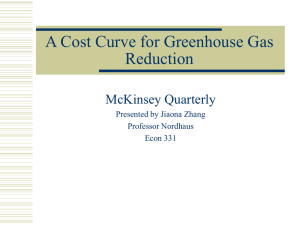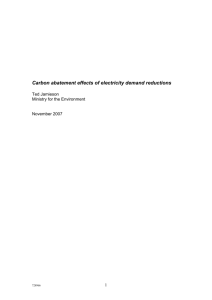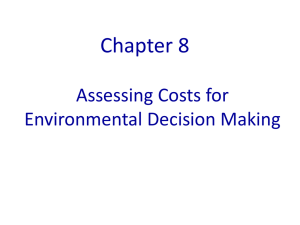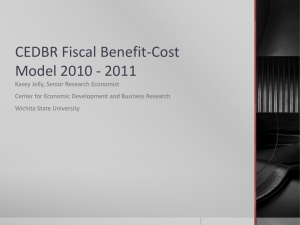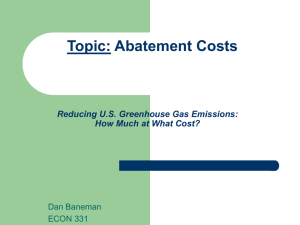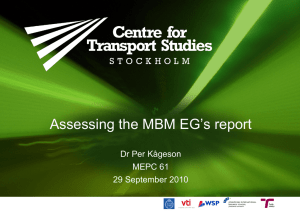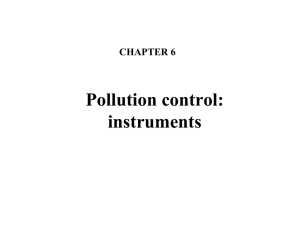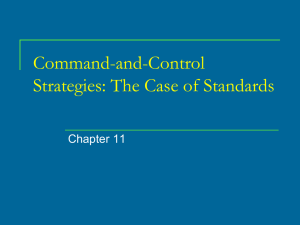Comparing Carbon Policies Internationally: the `challenges` (Word
advertisement
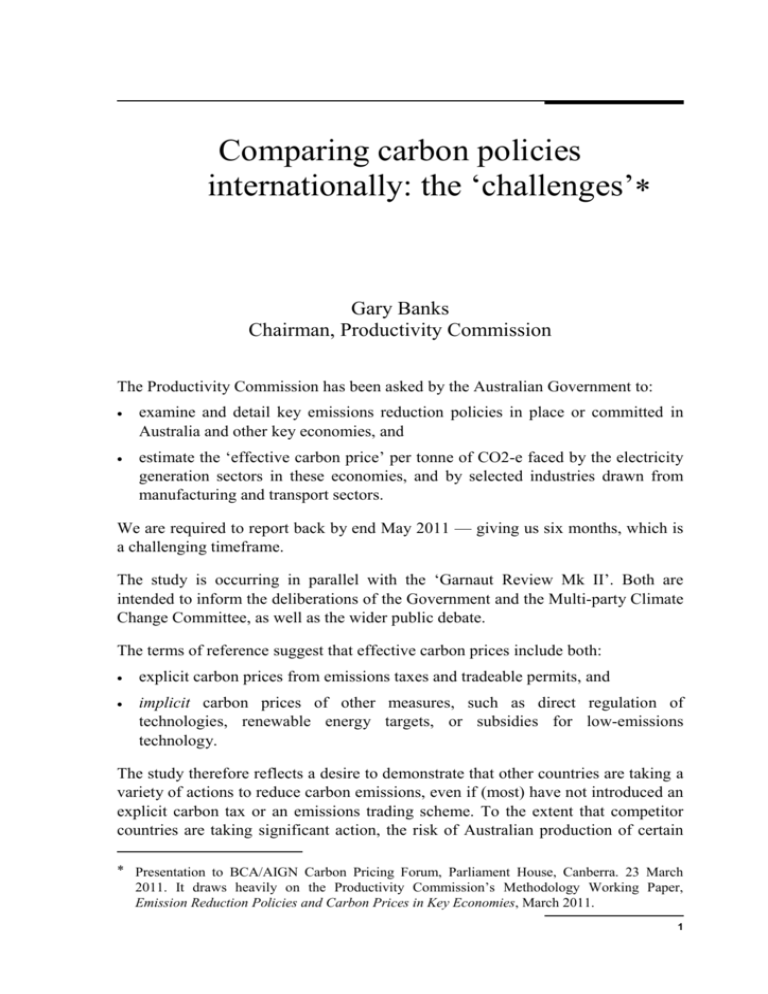
Comparing carbon policies internationally: the ‘challenges’ Gary Banks Chairman, Productivity Commission The Productivity Commission has been asked by the Australian Government to: examine and detail key emissions reduction policies in place or committed in Australia and other key economies, and estimate the ‘effective carbon price’ per tonne of CO2-e faced by the electricity generation sectors in these economies, and by selected industries drawn from manufacturing and transport sectors. We are required to report back by end May 2011 — giving us six months, which is a challenging timeframe. The study is occurring in parallel with the ‘Garnaut Review Mk II’. Both are intended to inform the deliberations of the Government and the Multi-party Climate Change Committee, as well as the wider public debate. The terms of reference suggest that effective carbon prices include both: explicit carbon prices from emissions taxes and tradeable permits, and implicit carbon prices of other measures, such as direct regulation of technologies, renewable energy targets, or subsidies for low-emissions technology. The study therefore reflects a desire to demonstrate that other countries are taking a variety of actions to reduce carbon emissions, even if (most) have not introduced an explicit carbon tax or an emissions trading scheme. To the extent that competitor countries are taking significant action, the risk of Australian production of certain Presentation to BCA/AIGN Carbon Pricing Forum, Parliament House, Canberra. 23 March 2011. It draws heavily on the Productivity Commission’s Methodology Working Paper, Emission Reduction Policies and Carbon Prices in Key Economies, March 2011. 1 goods shifting offshore following the introduction of a carbon tax here would be reduced (and so too the need for measures to prevent this happening). The Commission’s study follows a similar though narrower study conducted for the Climate Institute of Australia by Vivid Economics last year, which was widely reported (and proved a bit contentious). Our processes Given that this is largely a technical exercise, and that the timelines are tight, the Commission is proceeding differently from most other studies and inquiries it undertakes. For example, we have not sought public submissions. Nor will it be feasible for us to publish a draft report as such. Nonetheless, we are endeavouring to remain as accountable and transparent as possible. The Commission initially published a background paper on its website advising how it was going about conducting the study. In early December we held a workshop that brought together academics, consultants, public servants and representatives of industry to canvas some of the methodological and data issues involved. And just this morning we published a fairly detailed working paper on the methodological issues and approach we are following (which I’ll be drawing from in these remarks). Collecting and verifying the data Not surprisingly, the data and information needs for this study are challenging, to say the least, and would be so even with more time at our disposal. It’s important not only to collect information, but to confirm its accuracy and validity with the countries concerned. We have therefore been developing contacts through DFAT and its overseas posts to help us communicate and establish links with foreign government agencies. We are also dealing with expert bodies throughout the target countries, including the OECD, the NDRC in China, and the energy agencies in Japan and South Korea. And we are contracting consulting firms to help with the data collection task. Given their experience in the field, the Commission has engaged Vivid 2 Economics to cover most countries, and Resources for the Future to cover the United States. Other contractors include Frontier Economics — and the list is still growing. (I should emphasise that these organisations are helping with the ‘input’ side of our study, not the ‘outputs’ or bottom lines.) Along the way, we will share relevant data with key players as well as with the countries concerned, to help promote accuracy and minimise the risk of errors being detected after the event. Once the report is completed, we will release as much of the data as possible so that others can replicate what we have done if they wish. We will also be releasing a stocktake of all emission reduction policy measures that we have been able to identify in the target countries, covering all sectors and industries. Which countries and sectors? The coverage of the analysis could have important implications for the comparability and usefulness of any measures — hence, it has been important to develop consistent selection criteria. The terms of reference suggest that the study look at eight countries in addition to Australia: namely, the UK, USA, Germany, New Zealand, China, India, Japan and South Korea. The Commission is attempting to cover relevant policies in each of these countries, although accessing data is proving difficult for some and governmental cooperation varies. Some commentators have expressed concern that Australia’s main competitors in some markets are not included. This is true, but the world’s largest emitters are included, as are our most important trading partners. And we simply could not have done more in the time available. In addition to the electricity sector, the terms of reference suggest that effective carbon prices be estimated for selected industries drawn from the manufacturing and transport sectors, where relevant and data permitting (important provisos). Emissions associated with electricity generation and transport account for around half of Australia’s emissions, while manufacturing industries are both users of emissions-intensive inputs, particularly electricity, and generators of emissions themselves. So by assessing policies targeting electricity generation, our study would also be covering a significant proportion of abatement policies relevant to manufacturing. This is particularly so for emission-intensive trade-exposed industries that have a high reliance on electricity, such as aluminium production. 3 Our report will accordingly focus on electricity generation and road transport. Which policies? Many types of policy measure serve to reduce emissions and are thus potentially within the scope of the study. They include policies that may not explicitly mention emission reduction as an objective, but have a significant impact on emissions. Balancing the need to provide robust estimates for the countries selected against the data and time constraints, the Commission is proposing to estimate the impacts of policies that: are in place or committed (where ‘committed’ means they have a high probability of being implemented — for example, they are in the process of being or have been enacted) penalise emissions or give an incentive for abatement (explicit or implicit taxes and subsidies, regulations, but not voluntary schemes or R&D incentives — as the effects of both are considered too prospective and therefore uncertain) have the effect, even if not necessarily the explicit intent, of reducing emissions (for example, excise taxes on fuels) have a material impact on a country’s emissions in a sector and/or impose significant total costs. Subject to the important filter of materiality, these criteria would cover policies such as explicit carbon prices, taxes on fossil fuels and electricity production or consumption, feed-in tariffs for renewable energy production and renewable energy mandates (with or without certificates/credits), and biofuel content standards for transport fuels. One troublesome scoping issue relates to policies that encourage the production and consumption of high-emissions products, or which are specifically designed to counter the impacts of emissions reduction policies. Gross estimates of measures to reduce emissions may materially overstate abatement effort to the extent they are offset by interventions pulling in the opposite direction. Realistically, this study will not be able to account for all such policies, but it will attempt to document and possibly quantify the impacts of those that could substantially counter emissions reduction policies (reducing the incentive to abate). Such policies could also materially affect actual impacts on competiveness. 4 Methodological issues The methodological issues involved in this study are, again, very challenging (notice that that word that keeps coming up!). There are high-level conceptual problems, as well as methodological issues concerning how to estimate the impacts of the many different types of climate change policy in practice — often without full information about critical parameters. The terms of reference embody the presumption that there are both explicit and implicit prices that can be derived and added together to get an overall effective carbon ‘price’ for each sector in each country, which can then be compared with those estimated for other countries. Measuring effective carbon prices would be a relatively straightforward task if all countries applied economy-wide CO2 emission taxes or quota schemes, because the carbon ‘price’ — simply equivalent to the tax rate or the market price of emission permits — would be observable, and comparable. But none do. Instead, most countries apply a myriad of less transparent, more narrowly-focussed interventions designed to assist the production and consumption of selected, less carbon-intensive technologies, or which penalise particular emissions-intensive products and processes. So far, for example, we have identified 230 policies operating in Australia, over 300 in the United States (excluding many State-based schemes) and more than 100 in the United Kingdom. Even countries that have or are committed to carbon pricing/quota schemes (such as the UK, Germany, New Zealand and some states in the US) apply them only to a limited range of emitting activities. Once you move away from an economy-wide ‘pricing’ mechanism — to a multitude of fragmented schemes that target different products and emissions sources — comparable measurement becomes highly problematic. Comparing apples and oranges (and sticks and carrots) Thus the threshold conceptual issue for us has been to develop a consistent approach for measuring the many different interventions. In essence, is there a way of comparing apples and oranges? Understanding how the various policies actually work is an essential first step. Despite the variety of policy instruments, all policies designed to promote lower carbon emissions must somehow either provide incentives (carrots) to abate, or disincentives (sticks) to emit CO2, or both. 5 We have thus found it helpful to think of emission-reduction policies as falling into two camps: policies that penalise consumption of high emissions products policies that encourage production of low emissions ones. (Needless to say, some do a bit of both.) But, whichever side of the market or ‘margin’ policies target, they will have implications for the other. Policies that effectively tax one commodity implicitly subsidise others. And effective subsidisation of one commodity implicitly taxes others. A carbon tax, for example, raises the price of products generating carbon emissions (thus reducing demand for them) and, at the same time, it effectively subsidises production of low-emission substitutes by increasing the price they can charge in the market. (Indeed, the way a carbon tax works is conceptually identical to an import tariff — the only difference is that an import tariff subsidises local production at the expense of foreign goods, whereas the carbon tax encourages higher cost, low-emission domestic production at the expense of lower-cost, high emission domestic production. In both cases, domestic consumers pay the explicit ‘tax’ and implicit subsidy.) Many other greenhouse policies instead directly foster use of cleaner technologies or production of cleaner products. Sometimes they do this through explicit budgetary subsidies. More often than not they achieve it through mechanisms such as mandated targets where the transfers to producers of certain products or technologies are less transparent. Whether explicit or implicit though, the subsidy’s effect is the same. Where the schemes can differ is in relation to who pays for them — taxpayers or the households and firms that use the products. Where users pay, the policies will also generate some ‘demand-side’ abatement. The nitty gritty of measuring abatement costs Given the disparate nature and limited application of the many policies in place, what we are endeavouring to measure is the total economic (welfare) cost of individual policies and their associated abatement effects. (Indeed this the only metric we can sensibly attempt to measure absent comparable economy-wide carbon pricing mechanisms.) These costs can then be related to the abatement achieved — that is, the average cost of abatement — which is an indicator of the cost-effectiveness of the policies being analysed. 6 Essentially this means estimating the costs of inducing substitution on the supply side (the additional costs of production) plus the costs of reduced consumption where product prices have been pushed up. Minding your P’s and Q’s Our methodology paper goes through in some detail what is needed to measure the costs of abatement under the various policies. On the cost side, essentially we need to know what happens to prices (p’s) and quantities (q’s) in product markets as the result of a policy. An inherent difficulty of these measurements is that they involve comparing an existing situation with an unobserved counterfactual; that is, what would have happened in the absence of the policy. This requires assumptions about or estimates of the supply and demand responses to the policy. In a perfect world we would have well-specified models to estimate responses to policy shocks — but the world isn’t perfect and nor are models (even where they exist). In practice, we are unlikely to know very much about the prices and quantities that would prevail in the absence of the policies (the counterfactual) For policies that assist producers of low-emission products, the value of the assistance (‘subsidy equivalent’) is more easily calculated than their resource costs. Moreover, these production subsidy equivalents are of interest in themselves, because they capture the often hidden transfers to producers. Also, they are indicative of the true (resource) costs, though they generally will overstate them (because marginal costs are increasing). Effectively, we will be using estimates of subsidy equivalents to proxy resource costs. But, you guessed it, measuring subsidy equivalents isn’t a walk in the park either. For some policies, the producer price ‘uplift’ (the rate of subsidy) will be observable — for example for feed-in tariffs and explicit budget-funded unit production subsidies. For others — for example, quantity-related renewable targets — the subsidy rate will have to be inferred from production costs of the assisted technologies. Unfortunately, unlike total subsidy equivalents, there is no proxy measure of consumption costs. The ‘total tax equivalent’ of measures that increase consumer prices is not helpful although, of course, the explicit or implicit tax rate measures the price ‘wedge’ that drives the consumer response. We will be doing our best to estimate these costs and the associated abatement (as households and firms reduce 7 their consumption of emission-intensive products), but generally we will have to make informed judgements about the behavioural responses. Measuring abatement While risking sounding like a cracked record, measuring the abatement achieved under the various policies is no simple task either. And again the problem relates to the counterfactual — that is, how much abatement would have occurred without the policy? In the case of electricity generation, for example, the marginal generator can vary depending on the circumstances and this can have a substantial impact on the amount of abatement that can be attributed to an abatement policy. For example, if subsidised renewable electricity sourced from wind or solar displaces gas-fired electricity — or possibly even hydro electricity — the abatement achieved will be far less (maybe zero) compared with a situation where coal-fired electricity was displaced. This possibility is not fanciful — operators will displace higher cost energy sources before cheaper ones (coal). (This particular response would also reduce the costs of the policy.) Apportioning abatement to particular policies will also be problematic where policies interact — for example, Germany’s feed in tariff (FIT) encourages generation of wind and solar power. But Germany is also subject to the EU’s emissions trading scheme. Some studies suggest that the FIT simply increases the cost of achieving the abatement that would have occurred under the ETS anyway. If this is so, the additional abatement under the FIT is zero, and its abatement cost infinity. Additionality and energy efficiency measures There are a couple of policy areas where assumptions will be particularly crucial for the results. The first concerns additionality. Should countries get ‘credit’ for policies they would have implemented anyway for domestic reasons — such as reducing local pollution or raising revenue? While there might be a welcome by-product CO2 abatement dividend, this essentially is achieved at zero cost. This is a good thing for the globe — all countries should be encouraged to take actions to correct costly domestic distortions that would simultaneously reduce carbon emissions. Less clear is whether their domestically-beneficial actions provide a rationale for making other 8 countries take actions that do impose costs on their economies. Where appropriate, the Commission will present results under different assumptions about additionality. The second concerns energy efficiency policies (such as fuel standards for cars) which are often claimed to deliver net savings to individuals while delivering emissions abatement. In other words, they are said to impose negative abatement costs. Whether that is in fact the case depends on whether consumers don’t know what’s good for them (particularly over the longer term). On the other hand, if these policies do override reasonably rational consumer preferences, they will impose costs on them and abatement costs will be positive. (I should add that measuring the eventual abatement associated with such measures is also complicated by so-called ‘rebound effects’ and so on). As a result, any estimates will likely be assumption driven, and potentially wide ranging in some cases. A snapshot versus a policy lifetime Ideally, emission-reduction policies would be assessed over multiple years but, realistically, we can only look at a ‘snapshot’ of policy impacts. The Commission’s approach is a comparative static analysis in the sense that it compares what is with what might have been in the base year, which will be the most recent year in which we can obtain data. We realise that this approach could distort the comparability of policy impacts and, for some policies, will simply not make sense. For these we will attempt a multi-period approach. What will it all mean? If nothing else, I hope you will have sensed that delivering any estimates will require many assumptions to be made. Sensitivity analysis will be crucial and, as noted, we envisage producing feasible ranges rather than just point estimates. Notwithstanding the considerable measurement challenges, as far as possible, for each policy measure, a subsidy equivalent (as a proxy measure of total costs) and subsidy (average cost) per tonne of CO2 abated will be reported. However, as noted earlier, in some cases it will not be possible to isolate the abatement effects of particular measures. The Commission will also aggregate the subsidy equivalent measures to produce an estimate of the total and average abatement subsidy for each sector in each country. (This average abatement subsidy could be referred to, very loosely, as the ‘price’ of abatement achieved under the schemes analysed.) 9 These measures will facilitate comparison of the cost-effectiveness of different measures within and across countries. They will also be useful indicators of the resources that governments/communities are prepared to devote to encourage abatement. As far as possible, the Commission will also endeavour to estimate the overall product price ‘uplift’ that results from the various supply and demand side interventions in each sector for each country. But as noted earlier, in the absence of information about supply and demand elasticities, such estimates will depend on assumptions about these parameters. A carbon price equivalent: a step too far? I must emphasise, however, that the estimated cost or price uplift (per unit of output of a product) is not a carbon price equivalent and cannot be converted to one. The study that attracted attention last year divided the average cost uplift for electricity per MWh by the carbon intensity of baseload generation. But this ratio is not equivalent to a carbon price — a carbon price or tax set at the same rate would not generate the same level (or cost) of abatement. Importantly, such manipulations will produce a lower number for a carbon-intensive economy such as Australia, even if we achieved a similar amount of abatement to that of other countries. Comparing ‘effort’ Measuring abatement effort requires a clear sense of what it means and what level of effort by each country would be ‘efficient’. Even if all countries had identical carbon taxes, the impact of those ‘prices’ on economic measures such as GDP or consumption would differ according to the characteristics of each economy. Global tax or quota schemes would ensure that for those industries where the costs of abating exceeded the costs of paying the tax or buying permits, emissions would (efficiently) continue to be produced. Thus ‘effort’ should also be interpreted to include payments of carbon tax or payments for permits to continue emitting. Crucially — and this point seems not to be widely understood — it will not be efficient from a global perspective (let alone a domestic one) for a carbon-intensive economy, such as ours, to abate as much as countries that are less reliant on cheap, high-emission, energy sources. (Modelling by the Treasury in 2008 confirmed that under a global trading scheme Australia would be a large net purchaser of carbon permits.) 10 Modelling aside, it’s commonsense that achieving any given level of abatement is likely to be costlier in a country with a comparative advantage in fossil fuels. Without some idea of the amount and nature of abatement required by each country to achieve efficient global abatement, the Commission’s estimates can give little indication of the efficiency of the abatement measures analysed and great care will have to be taken interpreting them: 1. For example, a country that adopts more inefficient (and hence high cost) abatement opportunities may be given greater ‘credit’ than a country that achieves the same abatement at a lower cost. 2. A high explicit carbon tax or abatement subsidy does not necessarily indicate that a country experiences a greater proportionate impact on its economy, or emissions, than others. For the same reasons, an appropriate carbon price for Australia cannot readily be inferred from cross-country estimates of the abatement costs of existing schemes. However, the subsidy-equivalent-cum-abatement-‘cost’ estimates the Commission is able to calculate will facilitate further analysis of whether the abatement being achieved under existing policy instruments could be achieved at lower cost — for example, by replacing current schemes with a carbon tax. Finally, I should note that if it were possible to model ‘efficient’ carbon tax equivalents to achieve the abatement realised in each country, these would provide a more accurate indication of Australia’s relative ‘effort’. Competitiveness impacts As mentioned, we will endeavour to estimate the product price ‘uplift’ resulting from the bundle of policies analysed in each country. While useful, this price impact is only a first step towards assessing competiveness impacts. More sophisticated modelling would be required to assess the flow-on impacts on production costs and likely changes (if any) in world prices resulting from policy interventions internationally. Nevertheless, it’s again just commonsense that industries that are price takers on world markets have little scope to absorb higher costs relative to their competitors (all –q no +p). Moreover, assessing the ultimate impact on producers’ costs in Australia and abroad would also require that any policies serving to counter the cost impacts of emissions reduction policies be taken into account. 11 The potential for more efficient (lower-cost) ways of achieving the abatement already being achieved domestically is also highly relevant to competiveness effects. Replacement of high-cost by lower-cost schemes domestically has the potential to reduce impacts on business costs and production processes, irrespective of the policy settings in competitor economies. In conclusion Strolling past the office of one of the team members engaged in this work, I overheard the comment ‘this stuff is doing my head in’. I hope I haven’t done your heads in! But I do hope I have alerted you to the complexities and, importantly, limitations of what we are doing — and moreover what anybody feasibly could do. That said, I am confident the study will shed much light on what other countries are doing, how the various policies work, the uncertainties surrounding the efficacy of many of them, how much they achieve and at what cost. I hope you’d agree that that should still be a useful contribution to finding a solution to this ‘wicked’ policy problem. 12
